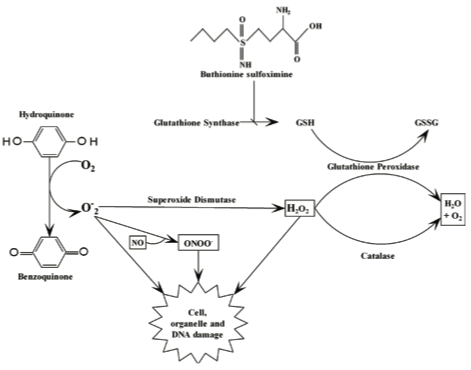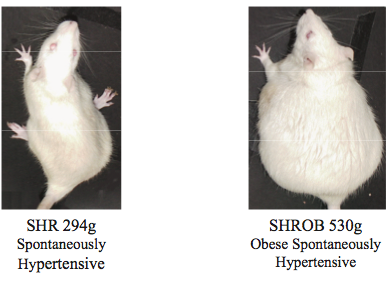From Discussions VOL. 5 NO. 2Proxidant Injection Causes the Onset of Type 2 Diabetes in the Spontaneously Hypertensive Obese (SHROB/Kol) Rat
IN THIS ARTICLE
KEYWORDS
AbstractThe spontaneously hypertensive obese (SHROB/Kol) rat is a model of prediabetes characterized by normal fasting and high postprandial glucose and insulin resistance. Oxidative stress, through the damaging effects of oxygen radicals, may contribute to the onset of diabetes. Oxidative stress was induced in SHROB with a combination of a proxidant agent, hydroquinone, and a glutathione synthase inhibitor, L-buthionine sulfoximine (both 50 mg/kg ip). Following proxidant injections, plasma peroxide levels were increased within 1 h and returned to baseline within 24h. Diabetes, defined as basal blood glucose in excess of 126 mg/dL, appeared within two days of daily treatment. Morning blood glucose values averaged over 200 mg/dl in SHROB injected with pro-oxidant solution versus about 100 mg/dl in control SHROB injected with saline. Glucose fell to baseline within 3d after cessation of proxidant treatment, but glucose tolerance remained significantly impaired. Food intake and body weight were not significantly affected by proxidant treatment at any point. Oxidative stress was measured by assay of peroxides in plasma. The SHROB rat subjected to oxidative stress is a potential model to study the onset of Type 2 diabetes, and supports the hypothesis that oxidative stress may be a trigger for diabetes onset in susceptible individuals. IntroductionApproximately 15 million Americans suffer from diabetes today (Candib, 2007). This serious illness exists in two forms, type 1 and type 2. Currently 5% of diabetics suffer from type 1, while 95% of diabetics suffer from type 2. Type 1 diabetes results from the autoimmune-mediated destruction of insulin-producing beta cells, which causes an absolute insulin deficiency. Multiple factors contribute to type 2 diabetes, including the combined influence of genetic susceptibility and environmental factors such as nutrition, obesity, age, and physical inactivity. In the early stages of the development of diabetes, prior to the onset of high glucose levels, these contributing factors result in insulin resistance compensated by insulin production that it adequate or even excessive (Candib, 2007). The next stage in the progression to diabetes is impaired glucose tolerance (Benjamin, Valdez, Geiss, Rolka, & Narayan, 2003). Human metabolic syndrome is characterized by a group of metabolic risk factors, including abdominal obesity, dyslipidemia, hypertension, insu-lin resistance, and impaired glucose tolerance. Metabolic syndrome is thought to play a role in increasing the risk for type 2 diabetes. Obesity contributes to all components of metabolic syndrome, especially in the presence of excess abdominal fat (Batsis, Nieto-Martinez, & Lopez-Jimenez, 2007). Increased weight, especially that caused by excess fat in the abdominal region, is associated with insulin resistance. For this reason, obesity is strongly associated with type 2 diabetes. However, this relationship is not absolute, as there are obese individuals who do not develop type 2 diabetes, as well as non-obese individuals who develop the disease (Karter et al., 2005). It is unclear why this is the case, leading to the question of which components in the body trigger diabetes in susceptible individuals. A proposed mechanism for the insulin resistance implicated in metabolic syndrome, and subsequently in type 2 diabetes, is through oxidative stress. Oxidative stress is characterized by an imbalance between the production of reactive oxygen species and a biological system's ability to detoxify reactive intermediates or easily repair the damage caused by these intermediates (Haidara, Yassin, Rateb, Ammar, & Zorkani, 2006). The natural cell environment of all living systems is reducing and this state is, for the most part, maintained through the action of certain enzymes which constantly provide a source of metabolic energy. The production of reactive oxygen species (ROS) disturbs this normal redox state through the production of peroxides and free radicals, substances which have been shown to have a damaging effect on almost all components of the cell and which may ultimately lead to cell death. This process is described in Figure 1. Figure 1: Experimental intervention in oxidative stress pathways. Rats were given hydroquinone, which yields superoxide when reduced to quinone. Additionally, the rats were given buthionine sulfoximine, a glutathione synthase inhibitor, which depletes the supply of this intracellular antioxidant. This reduces the breakdown of hydrogen peroxide and also interferes with other redox reactions in which glutathione participates. The combination of hydroquinone and buthionine sulfoximine leads to an imbalance of oxidative and antioxidant processes within cells, a condition known as oxidative stress.
Superoxide is a major reactive oxygen species in cells. As indicated in Figure 1, it directly damages cells, and reacts with nitric oxide to form an additionally damaging peroxynitrite radical. Superoxide is rapidly acted upon by superoxide dismutase to produce hydrogen peroxide, which is also detrimental to cells. Hydrogen peroxide is subsequently broken down by two pathways. First, the enzyme catalase works directly on hydrogen peroxide to produce water and molecular oxygen. Additionally, glutathione peroxidase breaks down hydrogen peroxide to oxidized glutathione (GSSG, with a disulfide bridge) with the help of the reduced form of glutathione (GSH, with a free thiol group) (Figure 1). The chemical stimulation of these pathways through the injection of hydroquinone and buthionine sulfoximine leads to oxidative stress, the imbalance of oxidative and antioxidant processes within cells. Oxidative stress has been implicated in the onset and progression of many diseases, including cancer, atherosclerosis, Parkinson's disease, Alzheimer's disease, and diabetes mellitus. In regards to diabetes, oxidative stress may contribute to pre-diabetic conditions such as insulin resistance and glucose intolerance, to diabetes itself, and to its complications such as retinopathy, nephropathy, neuropathy, stroke, and myocardial infarction (Keaney, Jr. et al., 2003). In this study, the effect of oxidative stress on blood glucose levels and the onset of diabetes was studied. Antioxidants form part of the oxidative stress pathway and aid in the degradation of hydrogen peroxide to oxygen and water. Endogenous antioxidants include superoxide dismutase (SOD), glutathione, and catalase. An-tioxidants can also be obtained exogenously from the diet, and are found in foods such as tomatoes, carrots, berries, garlic, and soy. Garlic's active principle, allicin, is thought to contribute significantly to the compound's antioxidant properties (Ernsberger, Johnson, Rosenthal, Mirelman, & Koletsky, 2007). Figure 2: Pictures of typical SHROB and SHR female rats at 12 weeks of age
Antioxidants are thought to decrease components of metabolic syndrome, including blood pressure, fat content of the bloodstream, and insulin resistance. Additionally, measuring levels of antioxidants present in the cell is one way to measure the degree of oxidative stress, as an increased presence of antioxidants signifies an increased response to proxidant stress. It is hypothesized that the mechanism of the onset of diabetes may be caused by oxidative stress in combination with obesity and diet, especially a diet lacking antioxidants. The SHROB rats used in this experiment exhibited metabolic syndrome (Figure 2). Metabolic syndrome is caused by genetic abnormalities and can be influenced by diet, physical activity, and medicines (Koletsky, Velliquette, & Ernsberger, 2007; Koletsky, Velliquette, & Ernsberger, 2003). This syndrome is characterized by abdominal obesity, dyslipidemia, hypertension, insulin resistance, and impaired glucose tolerance. These symptoms are all associated with, and often lead to, diabetes in humans; however, untreated SHROB rats remain in a prediabetic state. The obesity exhibited by this model results from a single point mutation leading to a premature stop codon in the leptin receptor, preventing translation of functional leptin receptors. Without these receptors, the effects of leptin on satiety are disrupted, and cause eating behaviors which lead to obesity. Other genetic mutations are responsible for the model's hypertension and dyslipidemia. However, these genes have not yet been fully identified. In combination, these genetic abnormalities form metabolic syndrome. Recently, a three-fold increase in plasma and organ lipid peroxides has been noted in SHROB relative to lean SHR littermates (Ernsberger, Theodorou, Edwards, & Koletsky, 2008). As such, we hypothesized that further increasing the elevated levels of oxidative stress in SHROB will be sufficient to trigger diabetes in this model.Continued on Next Page » Suggested Reading from Inquiries Journal
Inquiries Journal provides undergraduate and graduate students around the world a platform for the wide dissemination of academic work over a range of core disciplines. Representing the work of students from hundreds of institutions around the globe, Inquiries Journal's large database of academic articles is completely free. Learn more | Blog | Submit Latest in Health Science |





















